9.6 Assess Your UnderstandingPrinted Page 683
683
Concepts and Vocabulary
The area \(A\) of the sector of a circle of radius \(r\) and central angle \(\theta \) is \(A=\) ______________.
\(\displaystyle\dfrac{\theta r^{2}}{2}\)
True or False The area enclosed by the graph of a polar equation and two rays that have the pole as a common vertex is found by approximating the area using sectors of a circle.
True
True or False The area \(A\) enclosed by the graph of the equation \(r=f(\theta ),\) \(r\geq 0,\) and the rays \(\theta =\alpha \) and \(\theta =\beta ,\) is given by \(A=\int_{\alpha }^{\beta }f( \theta)\, d\theta .\)
False
True or False If \(x( \theta) =r\cos \theta ,\) \(y( \theta) =r\sin \theta \) are parametric equations of the polar equation \(r=f( \theta) ,\) then \(\left( \dfrac{dx}{ d\theta }\right) ^{2}+\left( \dfrac{dy}{d\theta }\right) ^{2}=r^{2}+\left( \dfrac{dr}{d\theta }\right) ^{2}.\)
True
Skill Building
In Problems 5–8, find the area of the shaded region.
\(r=\cos (2\theta)\)

\(\dfrac{\pi}{4}\)
\(r=2 \sin (3\theta)\)
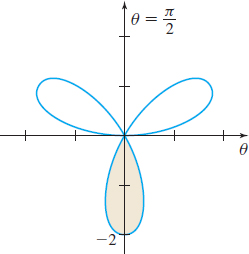
\(r=2+2\sin \theta\)

\(8 + 3\pi\)
\(r=3-3\cos \theta\)
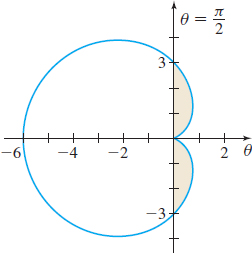
In Problems 9–12, find the area of the region enclosed by the graph of each polar equation swept out by the given rays.
\(r=3\cos \theta;\;\theta =0\;\hbox{to}\;\theta =\dfrac{\pi}{3}\)
\(\dfrac{3}{16}\big(3\sqrt{3}+4\pi\big)\)
\(r=3\sin \theta ;\;\theta =0\;\hbox{to}\;\theta = \dfrac{\pi }{4}\)
\(r=a\,\theta ;\;\theta =0\ \hbox{ to }\ \theta =2\pi \)
\(\dfrac{4\pi^{3}a^{2}}{3}\)
\(r=e^{a\,\theta };\;\theta =0\ \hbox{ to }\ \theta =\dfrac{\pi }{2}\)
In Problems 13–18, find the area of the region enclosed by the graph of each polar equation.
\(r=1+\cos \theta \)
\(\dfrac{3\pi}{2}\)
\(r=2-2\sin \theta \)
\(r=3+\sin \theta \)
\(\dfrac{19\pi}{2}\)
\(r=3(2-\sin \theta )\)
\(r=8\sin ( 3\theta ) \)
\(16\pi \)
\(r=\cos (4\theta ) \)
In Problems 19–22, find the area of the region enclosed by one loop of the graph of each polar equation.
\(r=4\sin ( 2\theta ) \)
\(2\pi\)
\(r=5\cos ( 3\theta ) \)
\(r^{2}=4\cos ( 2\theta ) \)
2
\(r=a^{2}\cos ( 2\theta ) \)
In Problems 23–26, find the area of each region described.
Inside \(r=2\sin \theta \); outside \(r=1\)
\(\dfrac{\sqrt{3}}{{2}} + \dfrac{\pi}{3}\)
Inside \(r=4\cos \theta \); outside \(r=2\)
Inside \(r=\sin \theta \); outside \(r=1-\cos \theta \)
\(1-\dfrac{\pi}{4}\)
Inside \(r^{2}=4\cos ( 2\theta ) \); outside \(r=\sqrt{2}\)
In Problems 27–30, find the surface area of the solid of revolution generated by revolving each curve about the polar axis.
\(r=\sin \theta ,\;0\leq \theta \leq \dfrac{\pi }{2}\)
\(\dfrac{\pi^{2}}{2}\)
\(r=1+\cos \theta ,\;0\leq \theta \leq \pi \)
\(r=e^{\theta },\;0\leq \theta \leq \pi \)
\(\dfrac{2}{5} \sqrt{2}(1+e^{2\pi})\pi\)
\(r=2a\cos \theta ,\;0\leq \theta \leq \dfrac{\pi }{2}\)
Applications and Extensions
In Problems 31–48, find the area of the region:
enclosed by the small loop of the limaçon \(r=1+2\cos \theta \).
\(\pi - \dfrac{3\sqrt{3}}{2}\)
enclosed by the small loop of the limaçon \(r=1+2\sin \theta \).
684
enclosed by the loop of the graph of \(r=2-\sec \theta \).
\(\sqrt{3} +\dfrac{4\pi}{3}-4\ln\big(2+\sqrt{3}\big)\)
enclosed by the loop of the graph of \(r=5+\sec \theta \).
enclosed by \(r=2\sin ^{2}\dfrac{\theta }{2}\).
\(\dfrac{3\pi}{2}\)
enclosed by \(r=6\cos ^{2}\theta \).
inside the circle \(r=8\cos \theta \) and to the right of the line \(r=2\sec \theta \).
\(4\sqrt{3}+\dfrac{32\pi}{3}\)
inside the circle \(r=10\sin \theta \) and above the line \( r=2\csc \theta \).
outside the circle \(r=3\) and inside the cardioid \(r=2+2\cos \theta \).
\(\dfrac{9\sqrt{3}}{2}-\pi\)
inside the circle \(r=\sin \theta \) and outside the cardioid \( r=1+\cos \theta \).
common to the circle \(r=\cos \theta \) and the cardioid \( r=1-\cos \theta \).
\(\dfrac{{7\pi}}{12} - \sqrt{3}\)
common to the circles \(r=\cos \theta \) and \(r=\sin \theta \).
common to the inside of the cardioid \(r=1+\sin \theta \) and the outside of the cardioid \(r=1+\cos \theta \).
\(2\sqrt{2}\)
common to the inside of the lemniscate \(r^{2}=8\cos ( 2\theta ) \) and the outside of the circle \(r=2.\)
enclosed by the rays \(\theta =0\) and \(\theta =1\) and \( r=e^{-\theta },\;\ 0\leq \theta \leq 1\).
\(\dfrac{1-e^{-2}}{4}\)
enclosed by the rays \(\theta =0\) and \(\theta =1\) and \( r=e^{\theta },\;\ 0\leq \theta \leq 1\).
enclosed by the rays \(\theta =1\) and \(\theta =\pi \) and \(r= \dfrac{1}{\theta },\;\ 1\leq \theta \leq \pi \).
\(\dfrac{\pi-1}{2\pi}\)
inside the outer loop but outside the inner loop of \(r=1+2\sin \theta \).
Area Find the area of the loop of the graph of \(r=\sec \theta +2\).
\(\sqrt{3}+\dfrac{4\pi}{3}-4\ \ln\big(2+\sqrt{3}\big)\)
Surface Area of a Sphere Develop a formula for the surface area of a sphere of radius \(R\).
Surface Area of a Bead A sphere of radius \(R\) has a hole of radius \(a\lt R\) drilled through it. See the figure. The axis of the hole coincides with a diameter of the sphere.
- (a) Find the surface area of that part of the sphere that remains.
- (b) Is the area found in Problem 29, Section 9.3, the same as the area found here? If not, justify the difference.
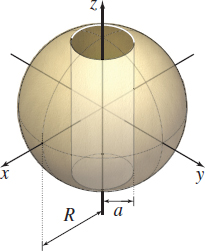
- (a) \(4\pi R\sqrt{R^2-a^2}\)
- (b) Answers will vary
Surface Area of a Plug A plug is made to repair the hole in the sphere in Problem 51.
- (a) What is the surface area of the plug?
- (b) Is the area found in Problem 30, Section 9.3, the same as the area found here? If not justify the difference.
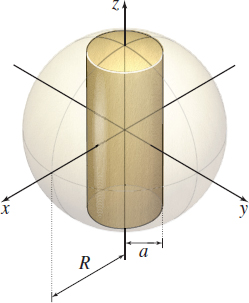
Area Find the area enclosed by the loop of the strophoid \(r=\sec \theta -2\cos \theta ,\;-\dfrac{\pi}{2}\lt\theta \lt \dfrac{\pi}{2}\) as shown in the figure.
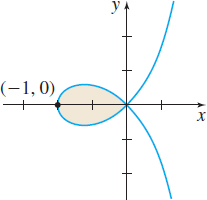
\(2-\dfrac{\pi}{2}\)
 Area
Area- (a) Graph the limaçon \(r=2-3\cos \theta .\)
- (b) Find the area enclosed by the inner loop. Round the answer to three decimal places.
Challenge Problems
Show that the area enclosed by the graph of \(r\theta =a\) and the rays \(\theta =\theta _{1}\) and \(\theta =\theta _{2}\) is proportional to the difference of the radii, \(r_{1}-r_{2}\), where \(r_{1}=\dfrac{a}{\theta _{1}}\) and \(r_{2}=\dfrac{a}{\theta _{2}}.\)
See Student Solutions Manual.
Find the area of the region that lies outside the circle \(r=1\) and inside the rose \(r=3\sin ( 3\theta )\).
Find the area of the region that lies inside the circle \(r=2\) and outside the rose \(r=3\sin ( 2\theta ) \).
\(2\sqrt{5}-\sin^{-1}\left(\dfrac{2}{3}\right)\)
